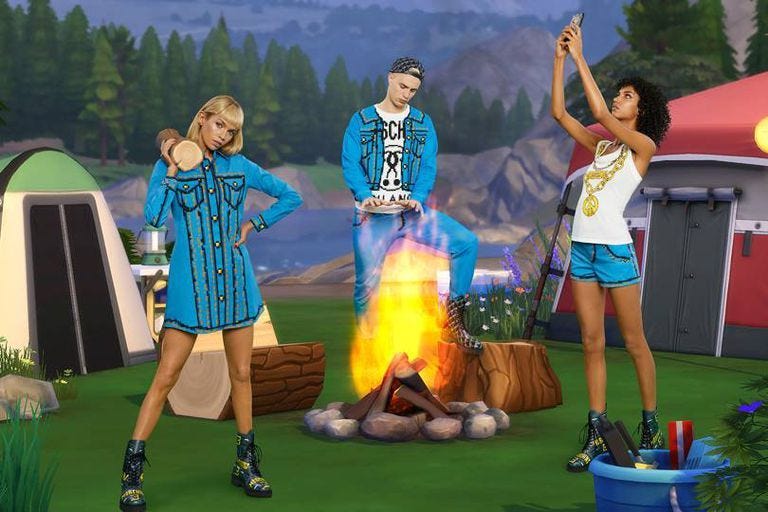
It should come as no surprise that fashion brands were first movers into the ever-expanding world of gaming from an advertising perspective; drawing on an almost impulsive need to constantly reinvent itself with new and younger audiences. But what began as a marketing differentiator specifically within the luxury brand category to break into a younger demographic segment has now become an almost elementary part of every fashion brand’s advertising strategy moving forward.
From in-game cosmetics (aka “skins”) to out-of-game physical collaborations, the intersection between fashion and gaming is fizzling with creativity that excites both gamers and the brands themselves. Here’s 3 successful examples that every brand looking to advertise to gamers can learn from.
1. Vans x Roblox
Nearly half of Roblox users (47%) say that dressing their avatars allows them to express their individuality, and 43% say it helps them feel good about themselves. A decent place to play if you’re a fashion brand, and that’s exactly what Vans thought too.
Last year they became the first fashion company to reach over 100 million Roblox visitors in its virtual skatepark and skate shop, “Vans World”. The permanent metaverse world allows players to skate with friends, compete in interactive challenges and complete tricks to collect virtual points. These gamified rewards can then be spent on customizable outfits and skateboards for their avatars within the virtual skate shop.
It seems so simple but there are a few major reasons why Vans World has been so successful. Firstly, they were one of the first to do it back in 2021, which certainly helped them create noise amongst the community. You can find endless organic YouTube videos from big gaming influencers with titles like “ROBLOX VANS WORLD.. is actually pretty good”, generating hundreds of thousands of views of free promotion — simply because it was something new coming to the gaming world.
But even more importantly, they made it fun, colorful and customisable. Challenges are still updated daily, keeping the experience fresh for players. What’s more, users can create their own custom Vans shoes to show off their unique style — a perfect way to allow a digitally native audience to interact with the brand virtually first, before (hopefully) becoming a buying consumer in the physical world later.
2. GUCCI x Fnatic
It’s common vernacular within the gaming world to say “GG” after a game — standing for “good game”. So with Gucci’s iconic GG logo, a gaming collaboration was written in the stars. And so back in 2020, the luxury brand made its move to partner up with esports royalty, Fnatic. The professional team based out of London is one of the most decorated teams in history, generally considered the “Real Madrid” of competitive gaming with 30M+ fans around the world.
The collaboration centered around the launch of a limited-edition Gucci Dive watch, a piece that perfectly encapsulates Gucci’s eclectic aesthetic whilst giving a subtle nod to the gaming slang for “diving” your opponent within the immensely popular title League of Legends. The watch featured the team’s logo and signature colors, and a premium ad spot was created featuring some of the biggest players from the team.
Even with quite a lofty price tag, the watch sold out within 48 hours in Europe and within a week in Asia. It also achieved substantial media attention, securing over 2 million views within a week and generating over 150 million readership across various articles.
3. Moschino x The Sims 4
Both known for their celebration of bold individuality, the collaboration between luxury brand Moschino and role-playing virtual simulation game The Sims 4 was a match made in pixelated heaven.
Spearheaded by Jeremy Scott, Moschino’s creative director, the physical capsule collection featured ready-to-wear clothes and accessories adorned with pixelated graphics and motifs from The Sims franchise, including the iconic Plumbob bathing suit and Freezer Bunny cell phone cover. The campaign photography also cleverly featured models being put inside the game itself to showcase digitized “lookbooks”. The collaboration extended into the game itself, with a purchasable “Moschino Stuff Pack” that included a Freezer Bunny hoodie amongst other things that players were able to customize their characters in.
The campaign smartly reached an older and more affluent demographic who nostalgically remembered playing Sims as a child; alongside introducing the brand to a new and younger cohort who were able to interact digitally.
Overwolf Ads allows advertisers to reach and engage gamers at scale during playtime across the world’s biggest games such as Fortnite, Minecraft, League of Legends and hundreds more.
If you’re interested in hearing more, head here.